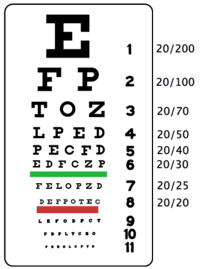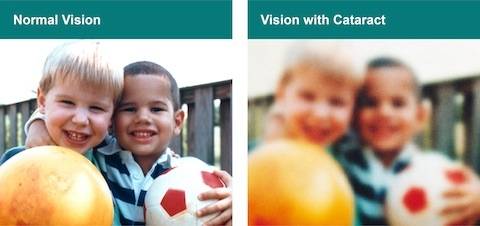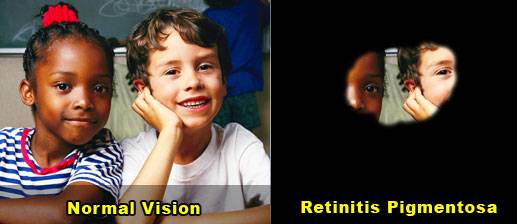Definition of Blindness
What does legally blind mean? The term “legally blind” originated as a means of determining who is eligible for certain government benefits. Most people who are legally blind still have some remaining vision.
Legal blindness number
In terms of numbers, while normal vision is 20/20, legal blindness is defined as 20/200 or less in one eye. So, if you’re looking at an object 200 feet in the distance, a person with 20/20 vision would be able to see the object clearly. On the other hand, someone who is legally blind would have to move closer — 20 feet away from the object — in order to see it clearly.

Source: https://www.afb.org
The experience of blindness
The experience of blindness is as unique as the person losing his or her sight. Various conditions, diseases, and injuries can cause vision loss, which can happen gradually over time. So being considered legally blind is not a one-size-fits all description; rather, it represents a wide range of real-life experiences of blindness.
Because light is required to see, total blindness describes the experience of having no light perception (NLP). That is, people who are totally blind can’t see any light or form.
If you still have some remaining vision, your condition is permanent and cannot be corrected with regular glasses, lenses, medicine or surgery, you have low vision. There are many different degrees of blindness within the overarching category of low vision.
Find out why when you sign up for our newsletter. You'll receive our best content and exclusive offers only for subscribers.
What does a blind person see?
Total blindness
Samuel, who was born completely blind, describes blindness as “nothingness.” If you are sighted, try closing one eye and focusing on something in front of you with your open eye. The closed eye sees nothing, comparable to the experience of someone who is totally blind.
Macular degeneration

Source: www.allaboutvision.com
Macular degeneration causes loss of central vision while peripheral vision is maintained.
Cataracts

Source: https://www.chatswoodeye.com/cataract-surgeons/
Cataracts cause blurry or cloudy vision, faded colors, shadows, and/or glare.
Diabetic retinopathy

Source: www.mteps.com
Diabetic retinopathy can cause blurry vision, color blindness, floaters, and/or total vision loss.
Retinitis pigmentosa (RP)

Source: www.wnycvi.org
RP causes loss of peripheral vision (eventually leading to “tunnel vision”). It can also cause loss of color perception and central vision.
What does it look like to be blind? What does it feel like to be blind?
Here are some simulations and descriptions.
“I got pretty depressed for a while. And then one day I said to myself, ‘I bet a blind person would give his right arm to have the vision I have.’ ”
— Don Knotts, the late co-star of The Andy Griffith Show and Three’s Company, diagnosed with MD at age 57
“I couldn’t see very well in dim light, and everything just looked clouded, like my glasses were smeared, but whenever I checked, they were clean. I was misreading words― for example, I would think ‘car’ looked like ‘cat,’ and then realize from context that I had gotten it wrong. When driving, by the time I got close enough to read a street sign, it was too late to turn. Night driving was the worst because each oncoming car looked like it had four headlights. It was hard to concentrate and see the road at night, especially if it was raining.”
— 78 year-old cataract patient, describing her experience prior to successful eye surgery
“My peripheral vision has been severely limited because of my diabetes, which means I can see just fine looking straight ahead. But if I am at a function with lots of people, I am constantly bumping into people – even kicking them!”
— Mary Tyler Moore, the late actress and star of The Mary Tyler Moore Show
“The rods and cones in the back of the eye literally die and do not provide light signals to the brain, concluding in blindness or partial blindness later in life. I do not have much of my peripheral vision left, and very little night vision. Normally sighted people have approximately 155 degrees of vision while looking straight ahead… whereas today I maintain only about 24 or 25 degrees of vision (both up and down and side to side) when looking ahead. To put it plainly, I see in tunnel vision.”
— Laura Lawson Visconti, personal trainer, diagnosed with RP at age 22
What does legally blind mean: wet macular degeneration vs dry
Even within the scope of one condition, there exists a range of different sight loss experiences. One important distinction is dry vs wet macular degeneration.
Wet vs dry macular degeneration
Dry macular degeneration tends to cause gradual vision loss over many years. Wet macular degeneration is more severe, often causing relatively sudden vision changes that may result in serious vision loss.
In the early stages of dry age-related macular degeneration, tiny drusen, or piles of waste product of the cells of the eye, appear on the retina. While nearly everyone over the age of 50 has at least one small drusen, with dry AMD, drusen can lead to deterioration of the retina.
With dry macular degeneration, you may notice visual distortions (such as straight lines appearing wavy or blurry), a reduction in central vision, a need for increased task lighting, greater difficult adjusting to lower light levels, fading color intensity, and/or a blind spot in your field of vision.
Dry MD can progress to wet macular degeneration, which causes leaking blood vessels under the retina. Wet AMD, representing about 10% of all cases of age-related macular degeneration, is a disease in which new, weak blood vessels form behind the retina, leaking fluids, lipids, and blood into the retina and macula. The leaking particles result in scar tissue and loss of function in the retinal cells.
In this short video, Dr. Nima Pakrou, Opthalmic Surgeon, summarizes the differences between dry and wet macular degeneration.
The leaking fluid may cause you to see a dark spot, or multiple dark spots, in the center of your vision.
There are two forms of wet macular degeneration. In the classic form, visual acuity is typically between 20/250 and 20/400, but may be worse than 20/800. The other type is known as “occult,” with a visual acuity between 20/80 and 20/200, and less leakage into the retina.
What is it like to be legally blind? What does legally blind mean to you? Tell us in your own words.
We hope this article has provided some insight into the broad and varied experiences of blindness. Sight loss affects so many people in so many different ways. We would be honored to hear about your own experience. What is it like to be blind? What do you see when you’re blind? What does legally blind mean to you? If you’d like to share, please leave a comment below.
Last updated April 20, 2022.
Author Information
By AdaptiVision staff. Reviewed by Stuart Flom.
Sources
“Boatmans Optical | Eye Care.” Boatmans Optical, www.boatmansoptical.co.uk/eye-care/cataracts?next=&id=10. Accessed 17 Dec. 2020.
Brody, Jane E. “AMDF Featured in The New York Times.” American Macular Degeneration Foundation, The New York Times Company, 29 June 2016, www.macular.org/feature/amdf-in-the-news.
Chatswood Eye Specialists. (n.d.). Cataract Surgeons Sydney – Chatswood Eye Surgeons. Retrieved April 20, 2022, from https://www.chatswoodeye.com/cataract-surgeons/
“Diabetic Retinopathy.” Eye Physicians & Surgeons – Billings MT, www.mteps.com/services/diabetic-retinopathy. Accessed 17 Dec. 2020.
“Dry Macular Degeneration – Symptoms and Causes.” Mayo Clinic, Mayo Foundation for Medical Education and Research (MFMER), 11 Dec. 2020, www.mayoclinic.org/diseases-conditions/dry-macular-degeneration/symptoms-causes/syc-20350375#:%7E:text=It%20can%20progress%20to%20wet,resulting%20in%20serious%20vision%20loss.
“Dry vs Wet Age-Related Macular Degeneration – AMDF.” American Macular Degeneration Foundation, www.macular.org/dry-vs-wet-macular-degeneration. Accessed 17 Dec. 2020.
Helmenstine, Anne Marie, Ph. D. “What Do Blind People See? Answer: Not All the Same Thing.” ThoughtCo, 22 Jan. 2020, www.thoughtco.com/what-do-blind-people-see-4153577#:%7E:text=Went%20Totally%20Blind%3A%20People%20who,colors%2C%20or%20flashes%20of%20light.
Kattouf, Valerie, OD, FAAO. “What Is Macular Degeneration?” All About Vision, 7 July 2020, www.allaboutvision.com/conditions/amd.htm.
Larson, Jennifer. “What Do Blind People See?” Healthline, Healthline Media, 20 Nov. 2019, www.healthline.com/health/eye-health/what-do-blind-people-see#types-of-blindness.
“Low Vision and Legal Blindness Terms and Descriptions | American Foundation for the Blind.” American Foundation for the Blind, www.afb.org/blindness-and-low-vision/eye-conditions/low-vision-and-legal-blindness-terms-and-descriptions. Accessed 17 Dec. 2020.
“Mary Tyler Moore Quotes.” BrainyQuote, BrainyMedia Inc, www.brainyquote.com/quotes/mary_tyler_moore_651141?src=t_diabetes. Accessed 17 Dec. 2020.
“My Cataract Experience Part 1.” Alabama Family Eye Care, 12 June 2018, www.alfamilyeyes.com/my-cataract-experience-part-1.
“Retinitis Pigmentosa Inherited Diseases Causing Retinal Degeneration.” WNY Center for the Visually Impaired, www.wnycvi.org/html/retinitis_pigmentosa.html. Accessed 17 Dec. 2020.
Visconti, Laura Lawson. “Going Blind in a Sighted World.” LAURA LAWSON VISCONTI, 24 Mar. 2015, lauralawsonvisconti.com/blog/rp.
WebMD, LLC. “What Does It Mean to Be Legally Blind?” WebMD, 25 Nov. 2015, www.webmd.com/eye-health/legally-blind-meaning#:%7E:text=If%20you’re%20legally%20blind%2C%20your%20vision%20is%2020%2F,and%20see%20that%20object%20perfectly.
“Wet Age-Related Macular Degeneration – AMDF.” American Macular Degeneration Foundation, www.macular.org/wet-amd. Accessed 17 Dec. 2020.
Wikipedia contributors. “Cataract.” Wikipedia, 9 Dec. 2020, en.wikipedia.org/wiki/Cataract#:%7E:text=A%20cataract%20is%20an%20opacification,and%20trouble%20seeing%20at%20night.














Hello as a little girl I wasn’t told I was blind from my left eye nor reported to anyone. Now that IAM 52 I can not work cause with my vision comes and goes from right eye and it’s a shame I feel helpless when it happens. Do I qualify for disability? My email is bopps247@gmail.com . User name…myliee
Hi there, thank you for writing. If you are in the US, we recommend contacting your local state agencies (often referred to as the state’s Association for the Blind or Division for the Blind & Visually Impaired). A good place to start is https://lowvision.preventblindness.org/resources/